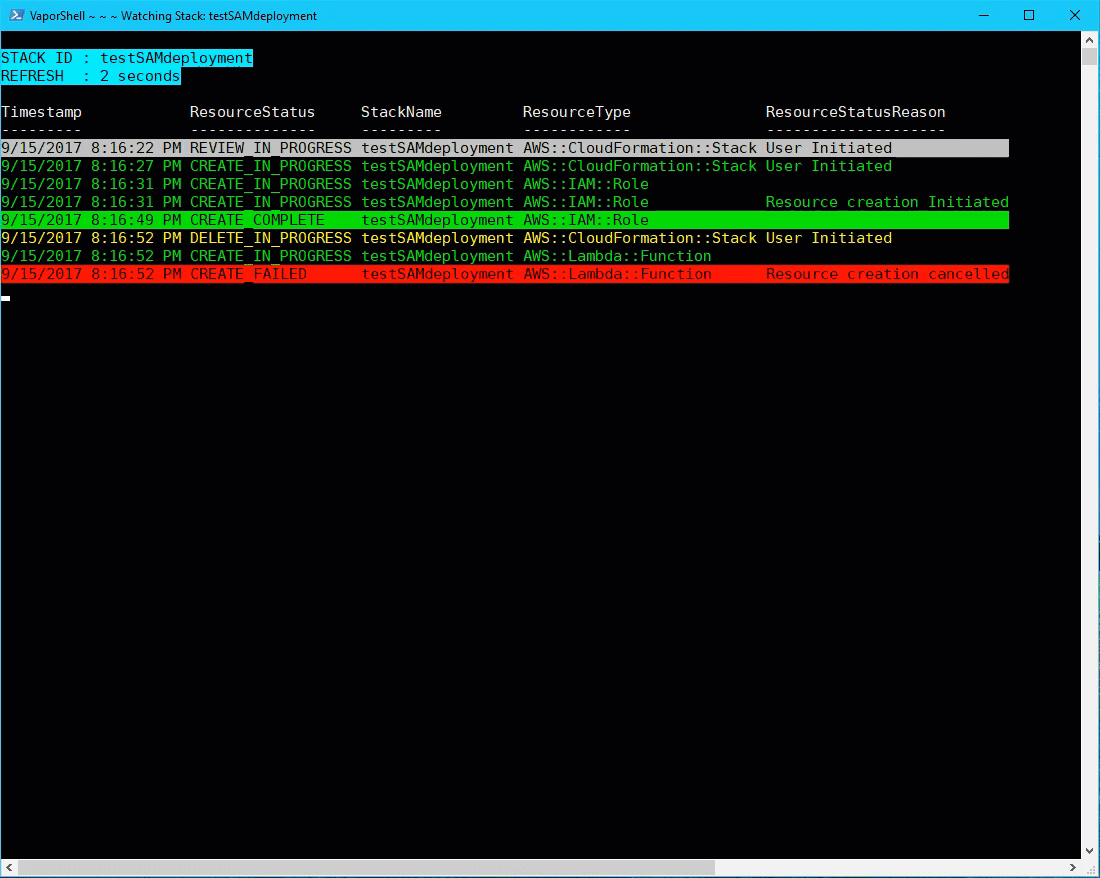https://github.com/SCRT-HQ/VaporShell
A PowerShell module for building, packaging and deploying AWS CloudFormation templates
https://github.com/SCRT-HQ/VaporShell
aws cfn cfndsl cloudformation cloudformation-template dsl json linux macos powershell serverless ubuntu
Last synced: 7 months ago
JSON representation
A PowerShell module for building, packaging and deploying AWS CloudFormation templates
- Host: GitHub
- URL: https://github.com/SCRT-HQ/VaporShell
- Owner: SCRT-HQ
- License: apache-2.0
- Archived: true
- Created: 2017-05-19T19:50:18.000Z (over 8 years ago)
- Default Branch: main
- Last Pushed: 2022-01-05T16:39:15.000Z (almost 4 years ago)
- Last Synced: 2024-11-02T16:03:58.412Z (about 1 year ago)
- Topics: aws, cfn, cfndsl, cloudformation, cloudformation-template, dsl, json, linux, macos, powershell, serverless, ubuntu
- Language: PowerShell
- Homepage: https://vaporshell.io
- Size: 26.9 MB
- Stars: 48
- Watchers: 7
- Forks: 9
- Open Issues: 4
-
Metadata Files:
- Readme: README.md
- Changelog: CHANGELOG.md
- Funding: .github/FUNDING.yml
- License: LICENSE
Awesome Lists containing this project
- awesome-cloudformation - VaporShell (PowerShell)
README

***
:pencil: :package: :rocket:
Build | Package | Deploy
A PowerShell module for building, packaging and deploying AWS CloudFormation templates :cloud:
## Table of Contents
* [Table of Contents](#table-of-contents)
* [Features](#features)
* [Prerequisites](#prerequisites)
* [Installation](#installation)
* [Tips](#tips)
* [Working with Credentials](#working-with-credentials)
* [Bare Necessities](#bare-necessities)
* [Examples](#examples)
* [In Action](#in-action)
* [License](#license)
* [Changelog](#changelog)
## Features
- __built from AWS's [CloudFormation spec sheet](http://docs.aws.amazon.com/AWSCloudFormation/latest/UserGuide/cfn-resource-specification.html):__ 100% coverage of all available resource and property types
- __runs on any OS:__ developed and tested in Windows, Ubuntu, and macOS on PowerShell v3-6
- __validates everything:__ built to make resulting templates reliable by leveraging parameter validation built into PowerShell
- __goes turbo:__ package and deploy your templates **fast** with one command: `vsl vaporize`
## Prerequisites
- PowerShell 3+
- On Linux or macOS? [Grab PowerShell 6 here!](https://github.com/powershell/powershell#get-powershell)
- .NET 4.5.0+ OR .netstandard 1.3+
- if you have PowerShell 4 or greater, you're covered!
**Recommended:** [ AWS Labs `cfn-flip`](https://github.com/awslabs/aws-cfn-template-flip)
> If you are working with YAML templates, you need to install `cfn-flip`. VaporShell uses `cfn-flip` under the hood to work with YAML templates, as PowerShell does not natively support YAML at this time. If you are only working in JSON, then `cfn-flip` isn't necessary.
## Installation
**[Preferred]** On PowerShell 5+ or [have PowerShellGet installed](https://www.microsoft.com/en-us/download/details.aspx?id=51451)? Install directly from the PowerShell Gallery:
```powershell
Install-Module VaporShell -Scope CurrentUser
```
**[Alternative]** Not on PowerShell 5+, can't install PowerShellGet, or policies blocking installation from remote sources? You're covered as well:
1. Head to the [Releases](https://github.com/SCRT-HQ/VaporShell/releases) section in the repo
2. Download the *VaporShell.zip* file attached to the latest release.
3. **If on Windows**: Right-click the downloaded zip, select Properties, then unblock the file.
> _This is to prevent having to unblock each file individually after unzipping._
4. Unzip the archive.
5. (Optional) Place the module folder somewhere in your `PSModulePath`.
> _You can view the paths listed by running the environment variable `$env:PSModulePath`_
6. Import the module, using the full path to the PSD1 file in place of `VaporShell` if the unzipped module folder is not in your `PSModulePath`:
```powershell
# In $env:PSModulePath
Import-Module VaporShell
# Otherwise, provide the path to the manifest file:
Import-Module -Path C:\MyPSModules\VaporShell\2.6.2\VaporShell.psd1
```
## Tips
### Working with Credentials
If you are planning on packaging or deploying to CloudFormation, you will need to setup credentials in your local Shared Credentials file. _If you are using the AWS command-line interface (CLI) and already have setup credentials, then you should be ready to go._
You can update or add a credential profile with `Set-VSCredential`:
```powershell
Set-VSCredential -AccessKey $accessKey -SecretKey $secretKey -Region USWest1 -ProfileName DevAccount
```
### Bare Necessities
When building templates with VaporShell, there are typically a few items that you'll want to include in your build script:
1. Create a template object by calling one of these into a variable
- `$template = Initialize-VaporShell`
- Use when starting from scratch
- `$template = Import-VaporShell -Path .\template.json`
- Use when importing from an existing template to build off of
2. Build out your template by using the object's ScriptMethods:
- `$template.AddResource()`
- `$template.AddParameter()`
- `$template.AddOutput()`
- etc....
3. Export your template to local file or `stdout` (useful for piping directly into `New-VSStack` or other functions that support TemplateBody as pipeline input)
- `Export-VaporShell -VaporshellTemplate $template -Path .\template.json`
- This will output the template as `template.json` in your working directory
- `Export-VaporShell -VaporshellTemplate $template`
- This will output the template to `stdout` as a single string
- `$template.ToJSON()`
- This script method on the template object performs the same function as `Export-VaporShell -VaporshellTemplate $template` and outputs the string template as JSON to `stdout`
- `$template.ToYAML()`
- This does the same thing as the `ToJSON()` script method, but outputs to YAML (`cfn-flip` required)
## Examples
```powershell
#1 Initialize a VaporShell object
$vsl = Initialize-VaporShell -Description "A function triggered on a timer."
#2 Add a Serverless function with local code as the CodeUri and a schedule of 5 minutes (split into multiple lines for readability)
$samFunction = New-SAMFunction `
-LogicalId "ScheduledFunction" `
-Handler "index.handler" `
-Runtime "nodejs6.10" `
-CodeUri ".\code" `
-Events (Add-SAMScheduleEventSource -LogicalId Timer -Schedule "rate(5 minutes)")
$vsl.AddResource($samFunction)
$TemplateFile = ".\sched-func.yaml"
#3 Save the template as YAML using the VaporShell object's ToYAML() method (uses cfn-flip to convert to/from YAML)
$vsl.ToYAML($TemplateFile)
<#4 Package and deploy (vsl vaporize) the template file (--tf $TemplateFile) as a change set with parameters:
- stack name (--sn) 'sched-func'
- S3 bucket also named 'sched-func' (defaults to the stack name if --s3 is not passed)
- capabilities: CAPABILITY_IAM (--caps iam)
- Verbose (--v) enabled
- Force (--f) enabled (make sure that the bucket is created and objects are uploaded)
- Watch (--w) the stack events in colorized output after executing the change
#>
vsl vaporize --tf $TemplateFile --sn sched-func --caps iam --v --f --w
```
Check out the [Examples page](https://vaporshell.io/docs/examples) for more.
## In Action
This is a deployment being watched via `Watch-Stack $stackName` to show stack creation and deletion mid-deploy:

## License
[Apache 2.0](https://tldrlegal.com/license/apache-license-2.0-(apache-2.0))
## Changelog
[Changelog](https://github.com/scrthq/VaporShell/blob/main/CHANGELOG.md)



